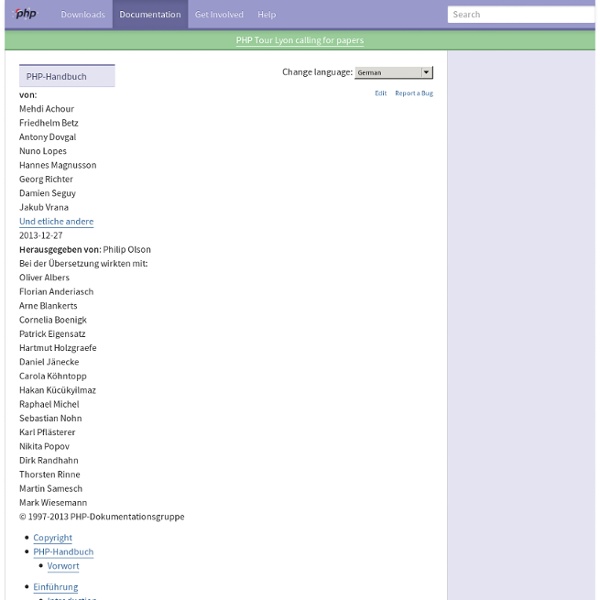



Mailing Lists There are many PHP-related mailing lists available on our server. Most of them are archived, and all of them are available as newsgroups on our news server. You can search some mailing lists right from this website from the search page or by using the search input box selecting the appropriate option on the top-right of every page. There is an experimental web interface for the news server at and there are also other archives provided by Marc. Twitter The PHP team maintains an official PHP.net account on twitter, @official_php, for those interested in following various information about the PHP project. Mailing List Posting guidelines When posting to mailing lists or newsgroups, please keep the following in mind: Use a valid email address. And make sure you have read our Mailinglist Rules. You will be sent a confirmation mail at the address you wish to be subscribed or unsubscribed, and only added to the list after following the directions in that mail.
News / php-journal - PHP Journal Was kann PHP? Alles. PHP ist hauptsächlich auf serverseitige Skripte fokussiert, weshalb Sie alles tun können, was auch ein anderes CGI-Programm kann, wie z.B. Formulardaten sammeln, dynamische Inhalte für Webseiten generieren oder Cookies senden und empfangen. Aber PHP kann noch viel mehr. Es gibt drei Hauptgebiete, in denen PHP-Skripte genutzt werden. Serverseitige Programmierung. PHP kann auf allen gängigen Betriebssystemen verwendet werden, inkl. So haben Sie die Freiheit, PHP auf dem Betriebssystem und dem Webserver Ihrer Wahl laufen zu lassen. Mit PHP sind Sie nicht auf die Ausgabe von HTML beschränkt. Vielleicht die größte und bemerkenswerteste Stärke von PHP ist seine Unterstützung für eine breite Masse von Datenbanken. Adabas D dBase Empress FilePro (nur Lesezugriff) Hyperwave IBM DB2 Informix Ingres InterBase FrontBase mSQL Direct MS-SQL MySQL ODBC Oracle (OCI7 und OCI8) Ovrimos PostgreSQL Solid SQLite Sybase Velocis Unix dbm
PEAR - PHP Extension and Application Repository Tutorial - Formulare verarbeiten mit PHP - Grundlagen Vorwort Da immer wieder Fragen auftauchen wie man Formulardaten in eine Datenbank schreiben und später wieder auslesen kann habe ich mich dazu entschlossen dieses kleine Anfängertutorial zu schreiben. Damit ein Benutzer mit einer Seite interagieren kann ist es nötig das eine Eingabemöglichkeit geschaffen wird: ein Formular. So ziemlich jede Webseite hat heutzutage mindestens ein Formular; sei es ein Gästebuch, Newsletter, Kontaktformular oder etwas anderes. Das beste Formular nutzt aber nichts, wenn man die eingegebenen Daten nicht verarbeiten kann und genau hier hilft uns eine Scriptsprache wie z.B. PHP. In diesem Tutorial schauen wir uns zunächst einmal an mit welchen Formular-Elemente wir es zu tun bekommen können. Auf Submit geklickt und jetzt? Schauen wir uns mal ein Formular an das die wichtigsten Elemente beinhaltet. <! Wer hier schon Probleme hat zu verstehen was er vor sich sieht, der sollte an dieser Stelle abbrechen und erst einmal HTML Grundlagen pauken! <?
Cascading Style Sheets What is CSS? Cascading Style Sheets (CSS) is a simple mechanism for adding style (e.g., fonts, colors, spacing) to Web documents. These pages contain information on how to learn and use CSS and on available software. They also contain news from the CSS working group. Software Nearly all browsers nowadays support CSS and many other applications do, too. Of course, all software has bugs, even after several updates. More » Learning CSS For beginners, Starting with HTML + CSS teaches how to create a style sheet. Another page also has some books, mailing lists and similar fora, and links to other directories. The history of CSS is described in chapter 20 of the book Cascading Style Sheets, designing for the Web, by Håkon Wium Lie and Bert Bos (2nd ed., 1999, Addison Wesley, ISBN 0-201-59625-3) More »
A Tourist's Guide Everyone knows the php.net site. All of us went there sooner or later, and will keep going back there. This is the central reference point for PHP users, and there is a wealth of information there. Not all of it is obvious. Come with me, I'll show you. This is the primary web site. This is the home of the download page, for everyone to get the latest version of the PHP source code and binaries for Windows. The next most visited section is the documentation. The support page has all the directions to a wealth of resources both inside and outside of PHP.net. Now, buckle up your seat belt, and stop smoking. This is where speakers at various PHP-related conferences keep their slides. news.php.net is the web interface to the PHP mailing lists. PEAR is the next revolution in PHP. PECL is a repository for PHP Extensions, providing a directory of all known extensions and hosting facilities for downloading and development of PHP extensions. PhD O.E. is an online documentation editor.
PHP Coding Ground ★ Free php scripts, mySQL, tutorials, Shared C Cookwood Press - Elizabeth Castro - HTML Books PHP.NET